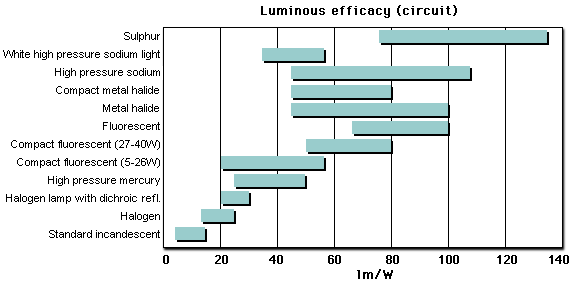Milett,
I do not want to discusse about money.
.
I look how effective a lamp is. I am an electrician, so I do not compare lamps by watt or size, I look what's going in and what I get out.
So in terms, if you want to use HID (High Intensity discharge) Lamps, you do.
But we must compare HID Lamps, because they differ.
In word, we have several HID families, and not all can compete with a modern flourescent tubular lamp....
So the least effecite lamp is the
Osram HQL, a Mercury Vapor Low Pressure Lamp... It works with only 40 Lumen per Watt.... and that's not what I call effective, because a tublar flourescent lamps of the Lumilux type has up to 80 lumen per Watt.... So only half of the light by the same amount of power you have to push in?
Is that realy HID ?? No, not realy, as we will see tubular lamps as NOT HID technlogy.
So, HQL are sold, even als plant lamps, but their light isn't well, it's not much and so you will add more heat radiation from the ballast and the bub to the air, as bring light to the plant's leaves...
So HQL: No way, even if you call it HID!
It's simply a fact, and what I want to have, is not 6 dozen of bulbs above the plants and a temperature like a bakery, I want to have less bulbs, less heat radiation from illumination and as much light as possible.
So HQL won't match these terms and any point.
So, real HID we get with Sodium Vapor Lamps, best with high Pressure, like the
Osram Vialox NAV or Philips SON-T.
Unfortunately, the do not match our demands in the spectral light radiation, because the nearly complete yellow orange light, emitted by those lamps, does not realy fit to the demands of the plants for photosyntesis... so even die Philips SON-T Agro with 30% more blue light radiation does not realy make it up.
The SON-T Agro is compareable to the
Osram Plantastar.
Both are Sodium Vapor Lamps, and realy more for canabis and flower growers, as for most home citrus growers....
So now we enter the section of high pressure metall halide lamps.
Usually Osram has two different types of those lamps, one with a quartz flare unit and one with a modern ceramic flare unit.
So the typical
Osram HQI is a quartz type, which matches our demands in color and light output. With about 3000 Kelvin and up to 5200 Kelvin is comes close to common daylight and the spectral color range is good, but still with peaks in the for sodium typical yellow orange color.
Up to 80 lumen per Watt you can get, and therefore now these lamps starting outbeating the flourescent tubular lamps in Lumn per Watt output and color range.
Now we got the first real HID lamps which fits in our demands....
But the best is to come:
with the
Osram HCI a new aera of metal halide technology was born, because their ceramic flare was able to widstand much higher temoratures and thus create much more and intense light. So output of more than 100 Lumen per Watt are recorded, by only light changes in spectral range, but beeing compareable to daylight.
The Osram brand Radium has a
Spectral picture here for their
Radium RCI-TS lamp, which comes with up to 91 Lumen per Watt...
So, if we compare lamps, the money one has to spend and one has to pay during runtime differs, not only from the point of energy, also from the point of light output.
And I prefer to spend my money in efficient light, rather in expensive lights, because one calls them 'high efficient'.... So much 'High output' Lamps exist, but a simple look to the technical details tels the whole story.
Does the spectral light fit? Does the light color, given by Kelvin, fit?
Is the Lumen per Watt value more than 40 Lumen per Watt?
These are the points we might think about, and because with that values, we can choose the right light, with less lamps but the desired light amount to spend our plants....
And that's why I choosed a flourescent lamp, because one tube, and I got enough light for two plants, whereas I had before mount two HQL bulbs... So I do not waste time, energy and money, after this decission and the plants... Well they do better than before....
So if we discuse about light, we do not discuse about decissions.. everyone is free to do his own, we discuse and compare only technical values... that's what I did and that's how my posting should be read... but with this technical values, you can do it on your own, and check up you decission, and choice, if you will install your next lamp.... and if not, nothing the be blamed for...
Oh, there is a picture, I can recomend:

He's got it from
3M.com Lighting and I found it on
Long Life for Art, Light technology for museums and galleries 























